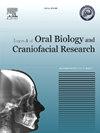“Effect of oral systemic administration of vitamin D on the rate of maxillary canine retraction: A randomized controlled trial”
Q1 Medicine
Journal of oral biology and craniofacial research
Pub Date : 2025-02-11
DOI:10.1016/j.jobcr.2025.01.017
引用次数: 0
Abstract
Objective
The trial was conducted to determine the effects of systemically delivered Vitamin D (1,25 dihydroxycholecalciferol) on the rate of maxillary canine retraction till the space closure and on the root resorption.
Materials and methods
A two-arm parallel randomized controlled trial was conducted in patients with Angle's Class I bimaxillary protrusion requiring at least upper first premolars extraction and distal movement of canine for malocclusion correction. The enrolled patients were randomized and allocated to the experimental group (Oral Vitamin D = 0.25 μg given) and control group (Placebo given). The canine retraction was initiated using nickel-titanium (NiTi) closed coil springs delivering a force of 100 gm per side and Vitamin D levels were monitored at monthly intervals. The patients' casts were digitally scanned and examined for differences in the rate of canine retraction at initial (T0), 4 weeks (T1), 8 weeks (T2), 12 weeks (T3), 16 weeks (T4) and 20 weeks (T5) intervals were calculated. The volumetric root resorption was done on CBCT of the area of interest at T0 and after completion of retraction. Descriptive statistics and paired t-test were used to determine any differences.
Results
32 patients (18–24 years) were randomized in the experimental group (n = 16) and control group (n = 16) and no dropout was noted till the end of the study. The results showed a statistically significant increase in the rate of canine retraction in the experimental group as compared to the control group at different time intervals. The differences in the mean canine retraction between group 1 and group 2 at T1-T0, T2-T1, T3-T2, T4-T3, and T4-T0 were 0.28 ± 0.12, 0.29 ± 0.10, 0.31 ± 0.08, 0.37 ± 0.06 and 1.18 ± 0.10 mm respectively. The total mean canine retraction for group 1 was achieved at T4 time interval while it was achieved at T5 interval for group 2. The intergroup comparison of maxillary canine roots showed no statistically significant difference in volumetric root resorption.
Conclusion
The active form of vitamin D can be an effective agent to accelerate orthodontic tooth movement (OTM).

口服维生素D对上颌犬内缩率的影响:一项随机对照试验
目的观察口服维生素D(1,25二羟基胆钙化醇)对上颌尖牙后缩至间隙闭合速度和牙根吸收的影响。材料与方法采用两臂平行随机对照试验,对需要至少拔除上颌第一前磨牙和犬齿远端运动矫治的双颌I类突出患者进行矫治。将入选患者随机分为实验组(口服维生素D = 0.25 μg)和对照组(口服安慰剂)。用镍钛(NiTi)封闭线圈弹簧启动犬的收缩,每侧施加100克的力,并每月监测维生素D水平。对患者的铸型进行数字扫描,计算初始(T0)、4周(T1)、8周(T2)、12周(T3)、16周(T4)和20周(T5)时间间隔内犬型牵出率的差异。在T0和牵开完成后,在感兴趣区域的CBCT上进行体积根吸收。采用描述性统计和配对t检验来确定差异。结果32例患者(18 ~ 24岁)随机分为实验组(n = 16)和对照组(n = 16),至研究结束均无退出现象。结果显示,在不同的时间间隔,实验组的犬只内收率与对照组相比有统计学意义的增加。1组与2组在T1-T0、T2-T1、T3-T2、T4-T3和T4-T0的平均犬牙内缩回量差异分别为0.28±0.12、0.29±0.10、0.31±0.08、0.37±0.06和1.18±0.10 mm。1组犬总平均牵出时间间隔为T4, 2组为T5。两组间比较,上颌牙根体积吸收差异无统计学意义。结论活性维生素D是促进正畸牙齿运动的有效药物。
本文章由计算机程序翻译,如有差异,请以英文原文为准。
求助全文
约1分钟内获得全文
求助全文
来源期刊

Journal of oral biology and craniofacial research
Medicine-Otorhinolaryngology
CiteScore
4.90
自引率
0.00%
发文量
133
审稿时长
167 days
期刊介绍:
Journal of Oral Biology and Craniofacial Research (JOBCR)is the official journal of the Craniofacial Research Foundation (CRF). The journal aims to provide a common platform for both clinical and translational research and to promote interdisciplinary sciences in craniofacial region. JOBCR publishes content that includes diseases, injuries and defects in the head, neck, face, jaws and the hard and soft tissues of the mouth and jaws and face region; diagnosis and medical management of diseases specific to the orofacial tissues and of oral manifestations of systemic diseases; studies on identifying populations at risk of oral disease or in need of specific care, and comparing regional, environmental, social, and access similarities and differences in dental care between populations; diseases of the mouth and related structures like salivary glands, temporomandibular joints, facial muscles and perioral skin; biomedical engineering, tissue engineering and stem cells. The journal publishes reviews, commentaries, peer-reviewed original research articles, short communication, and case reports.
 求助内容:
求助内容: 应助结果提醒方式:
应助结果提醒方式:


